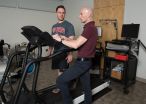(Press-News.org) Instead of shrinking as expected, as part of the normal aging process, the memory center in the brains of seniors maintained their size and, in men, grew modestly after two years in a program that engaged them in meaningful and social activities, new Johns Hopkins Bloomberg School of Public Health-led research suggests.
At the same time, those with larger increases in the brain's volume over two years also saw the greatest improvements on memory tests, showing a direct correlation between brain volume and the reversal of a type of cognitive decline linked to increased risk for Alzheimer's disease.
The research, published online in Alzheimer's & Dementia: The Journal of the Alzheimer's Association, studied participants in the Baltimore Experience Corps, a program that brings retired people into public schools to serve as mentors to young children, working with teachers to help them learn to read in understaffed school libraries.
"Someone once said to me that being in this program removed the cobwebs from her brain and this study shows that is exactly what is happening," says study leader Michelle Carlson, PhD, an associate professor in the Department of Mental Health at the Johns Hopkins Bloomberg School of Public Health. "By helping others, participants are helping themselves in ways beyond just feeding their souls. They are helping their brains. The brain shrinks as part of aging, but with this program we appear to have stopped that shrinkage and are reversing part of the aging process."
For the study, Carlson and her colleagues randomized 111 men and women to either participate in the Experience Corps (58) or not (53). They took MRI scans of their brains at enrollment and then again after 12 and 24 months. They also conducted memory tests. Participants were an average of 67.2 years old, predominantly African-American, were in good health, came from neighborhoods with low socioeconomic status and had some college education.
The control arm of the study, those not involved in Experience Corps, exhibited age-related shrinkage in brain volumes. Typically, annual rates of atrophy in adults over age 65 range from .8 percent to two percent. The men who were enrolled in Experience Corps, however, showed a .7 percent to 1.6 percent increase in brain volumes over the course of two years. Though not statistically significant, women appeared to experience small gains, as compared to declines in the control group of one percent over 24 months.
Carlson notes that many cognitive intervention studies last one year or less. One strength of this study, she says, is that the participants were followed for two years, which in this case was long enough to see changes that wouldn't have been detected after just one year.
The researchers were particularly interested in the results, considering that people with less education and who live in poverty are at greater risk for cognitive decline.
Carlson says it's not entirely clear which elements of Experience Corps account for the improved memory function and increased brain volumes. She says the program increases involvement in so many different kinds of activities that retired people may not have engaged in otherwise. Participants need to get out of bed, walk to the bus, and walk up and down stairs inside the schools. They work in teams. They work with young people. They share their knowledge and know they are doing good in the world. They engage in problem solving and they socialize in ways they wouldn't have if they stayed at home.
"We're not training them on one skill, like doing crossword puzzles," she says. "We're embedding complexity and novelty into their daily lives, something that tends to disappear once people retire. The same things that benefit us at 5, 10, 25, 35 - contact with others, meaningful work - are certain to benefit us as we age."
Experience Corps is a national program, however it can be costly and isn't available everywhere. But Carlson says she believes finding purpose and civic engagement may forestall some of the damage of aging on the brain.
INFORMATION:
"Impact of the Baltimore Experience Corps Trial on cortical and hippocampal volumes" was written by Michelle C. Carlson, Julie H. Kuo, Yi-Fang Chuang, Vijay Varma, Greg Harris, Marilyn Albert, Kirk I. Erickson, Arthur F. Kramer, Jeanine M. Parisi, Qian-Li Xue, Erwin Tan, Elizabeth K. Tanner, Alden Gross, Teresa E. Seeman, Tara Gruenewald, Sylvia McGill, George W. Rebok and Linda P. Fried.
The study was supported by the Johns Hopkins Neurobehavioral Research Unit, the National Institutes of Health's National Institute on Aging (P01 AG027735-03), the Alzheimer's Drug Discovery Foundation and the Johns Hopkins Epidemiology and Biostatistics of Aging Research Fellowship (NIA T32AG000247).
WASHINGTON - Gradual and variable change in mental functions that occurs naturally as people age, not as part of a neurological disease such as Alzheimer's disease, is one of the most challenging health issues encountered by older adults, says a new report from the Institute of Medicine. The aging process affects the brain just like any other part of the body. Known as "cognitive aging," the type and rate of change can vary widely among individuals. Some will experience very few, if any, effects, while others may experience changes in their memory, speed of processing ...
COLUMBIA, Mo. - Following the 2012 shooting in Newtown, Connecticut, some in the media and the public speculated a link existed between autism spectrum disorder and violence and, in particular, that violent video games may cause gamers with autism to act violently. Now, a study from the University of Missouri has found evidence to contradict this speculation. It is the first study to test the effects of violent video games on aggression in adults with autism spectrum disorder.
"If violent video games caused adults with autism spectrum disorder to behave aggressively, ...
Messages conveyed on websites may be more persuasive if theses websites are interactive, according to researchers.
In a study, participants who visited an interactive antismoking website were more likely than controls to say that smoking was an unattractive behavior, and more likely to agree with the site's stance against smoking.
"When interface features are perceived as natural, easy to use and intuitive, users will feel more focused and have more fun during browsing," said Jeeyun Oh, assistant professor of communications, Robert Morris University and former Penn ...
A group of plant invasion ecologists from University of Delhi, India have highlighted the need to disentangle the composition of the highly variable Lantana species complex in order to facilitate management efforts towards this highly invasive species. The study was published in the latest issue of the open access journal NeoBiota.
The native range of L. camara is Central and South America; however it has become naturalized in around 60 tropical and sub-tropical countries worldwide. The plants from this species complex are highly invasive and often colonize previously ...
The efficient conversion of light into electricity plays a crucial role in many technologies, ranging from cameras to solar cells. It also forms an essential step in data communication applications, since it allows for information carried by light to be converted into electrical information that can be processed in electrical circuits. Graphene is an excellent material for ultrafast conversion of light to electrical signals, but so far it was not known how fast graphene responds to ultrashort flashes of light.
ICFO researchers Klaas-Jan Tielrooij, Lukasz Piatkowski, Mathieu ...
Publicly funded labiaplasties in Australia and the United Kingdom have more than doubled over the last decade, leading experts will say tomorrow at the RCOG/RANZCOG World Congress in Brisbane, Australia.
In the UK, the number of labial reduction procedures has risen five-fold in the NHS over the past 10 years, with over 2,000 operations performed in 2010. In Australia, statistics published in the Medical Journal of Australia in 2011 estimated that approximately 1,500 labiaplasty and vulvoplasty operations were performed in 2010.
In a session dedicated to discussing ...
Women's human rights need to be addressed globally in order to reduce maternal mortality and morbidity, says RCOG Vice President, Professor Lesley Regan, in her lecture tomorrow at the joint RCOG/RANZCOG World Congress in Brisbane, Australia.
Professor Regan's presentation 'Why mothers die: Women's human rights' focuses on the impact of human rights on women's reproductive health and the role of healthcare professionals in improving the status of women worldwide.
In 1948, the Universal Declaration of Human Rights stated that all human beings are born free and equal ...
UC Davis scientists are leading three new research projects, recently funded with more than $5 million in grants from the U.S. Department of Agriculture's National Institute of Food and Agriculture.
These grants are part of USDA's $19 million effort to ensure the availability of a safe, nutritious and economically competitive food supply.
Preventing cross-contamination in produce processing:
One project will focus on preventing foodborne illnesses by developing and eventually commercializing new fresh-produce processing technologies and methods. The new systems will ...
As preparations are made to observe Holocaust Remembrance Day (Thursday, April 16), a new Bar-Ilan University study reveals that the adult children of Holocaust survivors are more preoccupied with the threat of a nuclear Iran than their peers whose parents are not Holocaust survivors.
The study, entitled "Transmitting the Sum of All Fears: Iranian Nuclear Threat Salience Among Offspring of Holocaust Survivors" was published in a recent issue of Psychological Trauma, an American Psychological Association journal dedicated to the study of trauma and its aftermath.
Study ...
COLUMBUS, Ohio - Exercise researchers have developed a new treadmill that automatically changes speed to match the pace of the runner.
The automated treadmill uses sonar to tell exactly where the runner is on the treadmill. If the runner picks up pace and moves toward the front of the running belt, the speed automatically increases. If the runner slows down and moves toward the back, the speed decreases.
The result is a treadmill experience that is much closer to walking or running outdoors, said Steven T. Devor, associate professor of kinesiology at The Ohio State ...


